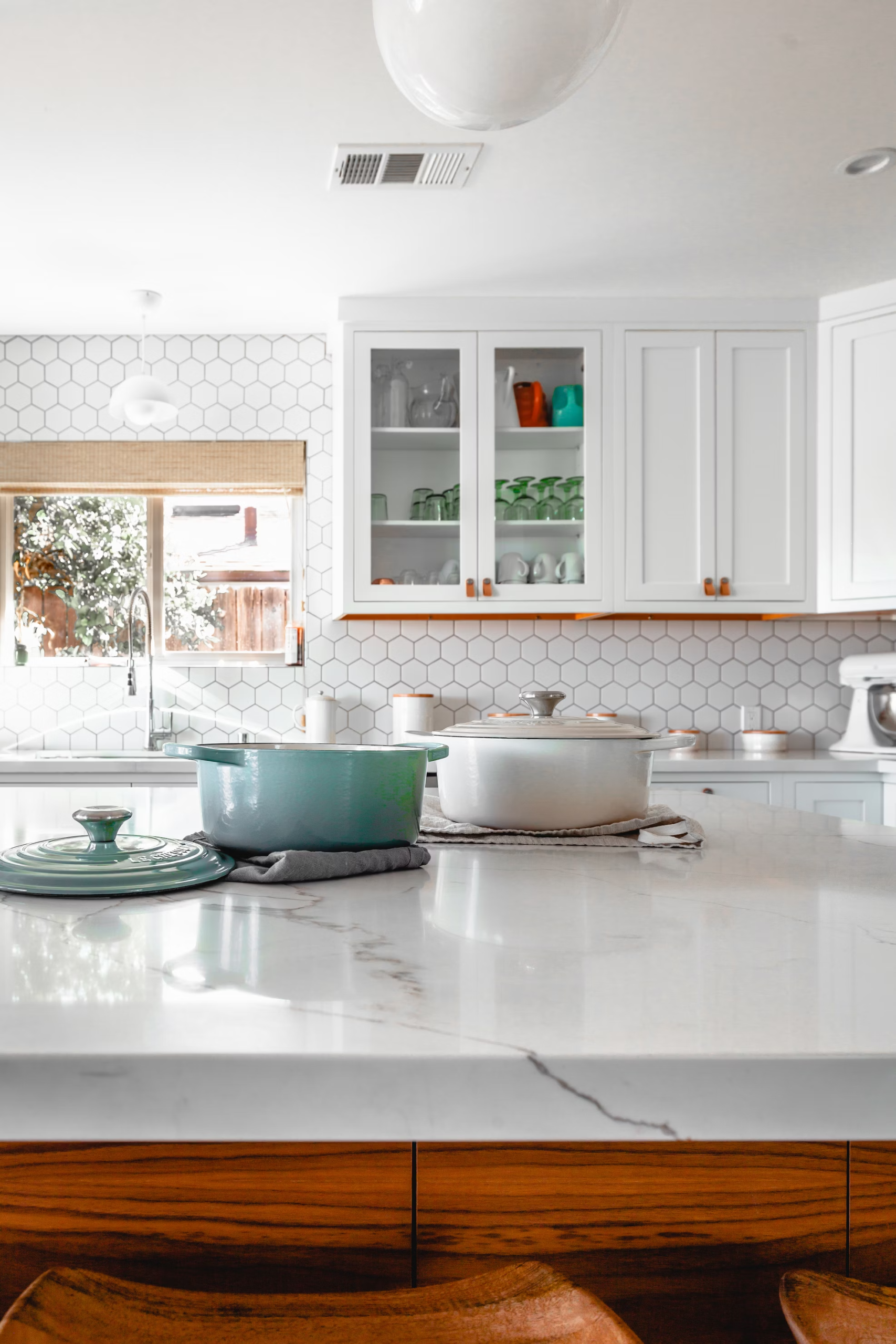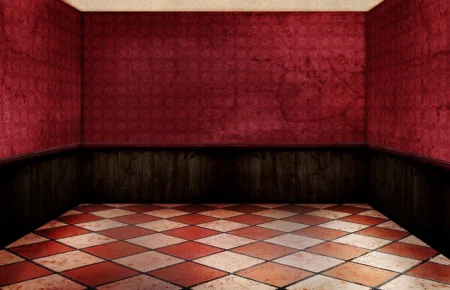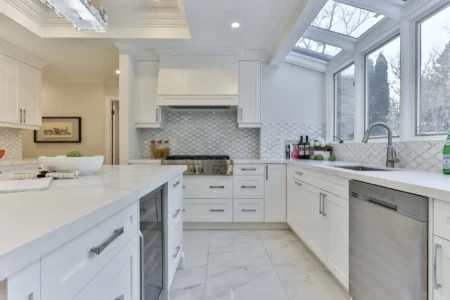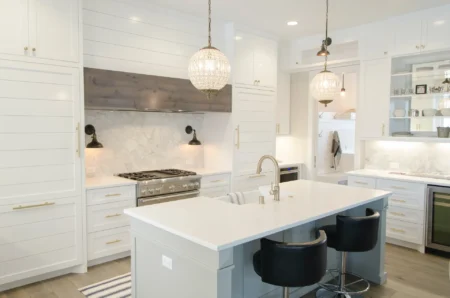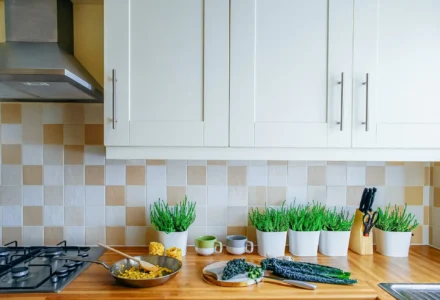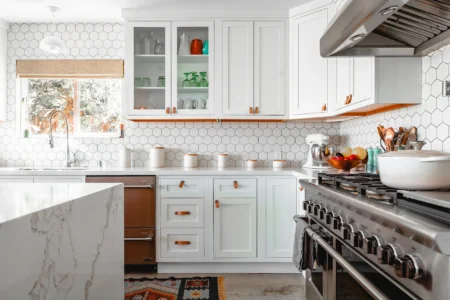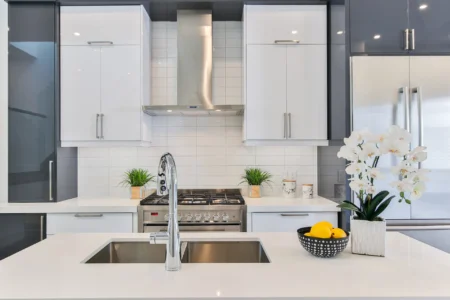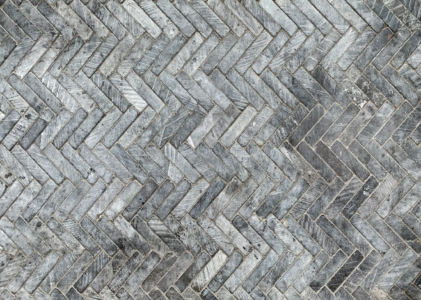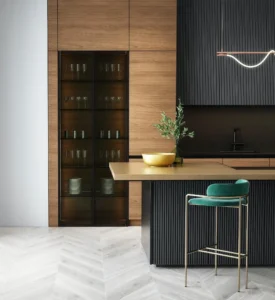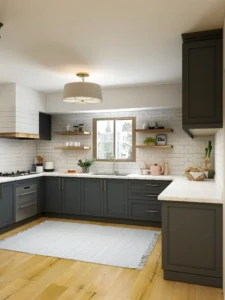Making the best tile selection for your kitchen might be challenging. It’s simple to become confused with the abundance of alternatives on the market. But don’t worry—this blog article is here to help you through the procedure. We’ll go through how to select the best tile material for your kitchen, look at the newest trends in kitchen tile, and offer advice on how to match your kitchen tiles with your countertops and cabinets. So let’s get started
How to Choose the Right Tile Material for Your Kitchen
It’s critical to comprehend the significance of selecting the proper tile material for your kitchen before we go into the specifics. The kitchen is a space with a lot of activity and is frequently subject to spills, heat, and heavy objects. The tile you select should thus be able to endure everyday use as well as improve the visual appeal of your kitchen.
- Ceramic tiles are a common option for kitchens because of their durability and adaptability. They are constructed of clay and heated to a hardness that makes them resistant to heat, stains, and scratches. Ceramic tiles are available in a variety of hues, designs, and sizes, enabling you to give your kitchen a special appearance. To ensure your safety, use a textured surface because they might be a little slippery when wet.
- Porcelain tiles are a more thick and long-lasting kind of ceramic tile. Because they are burned at a higher temperature, they are less porous and stain- and moisture-resistant. Given its durability and ease of maintenance, porcelain tiles are a great option for kitchens. They may, however, cost more than other types of tile materials.
- Natural Stone Tiles: Natural stone tiles, such granite, marble, and slate, give your kitchen a refined, upscale feel. They are perfect for kitchen countertops and backsplashes since they are strong and heat-resistant. To avoid stains and damage, natural stone tiles must be regularly sealed.
- Glass tiles are a sleek and contemporary alternative for your kitchen. Because they are non-porous, they are able to withstand stains and germs. Glass tiles reflect light, giving the impression that your kitchen is bigger and brighter. However, they might need to be handled carefully because they can be easily scratched.
- Vinyl tiles are a cost-effective solution for your kitchen. They come in a variety of styles and are soft underfoot. Vinyl tiles are a common option for DIY enthusiasts since they are simple to install and maintain. They might not be as resilient as other tile materials, though.
The best tile for your kitchen will rely on your spending limit, way of life, and aesthetic preferences. It’s crucial to weigh the advantages and disadvantages of each material before choosing one.
Kitchen Tile Trends: What’s Hot
Kitchen design is a dynamic field, and tile trends are no different. Keeping up with the most recent trends will help you make an informed choice and design a kitchen that is both elegant and practical. Let’s look at some of the newest trends in kitchen tiling.
- Large Format Tiles: Kitchen design is embracing large format tiles. These tiles, which are bigger than the typical 12×12-inch size, eliminate grout lines to produce a smooth, open appearance. They are ideal for tiny kitchens since they may enlarge the room. However, installation might be challenging and may need for expert assistance.
- Subway tiles are a traditional material that are always in trend. They got their name from the white, rectangular tiles that were common in early 20th-century subway stations. Since they are so adaptable, subway tiles may be used in both conventional and modern kitchen designs. Because they come in a variety of colors and finishes, you may personalize the appearance to suit your tastes.
- Patterned tiles are a wonderful way to give your kitchen flair and visual intrigue. They have a variety of patterns, from floral themes to geometric patterns. Patterned tiles may be utilized to create a subtle, textured floor or a striking, statement backsplash.
- Metallic tiles are a stylish option for people who want to give their kitchen a little glitz. They reflect light, giving the impression of extra light and space in your kitchen. There are several types of metallic tiles, including gold, silver, and bronze.
- Timber-Looking Tiles: The warmth and beauty of wood are combined with the toughness and low maintenance of tiles in wood look tiles. They are a great alternative for people who adore the appearance of hardwood but prefer something more useful for their kitchen.
Remember, trends come and go, but your kitchen is a long-term investment. Choose a tile trend that aligns with your personal style and the overall design of your home.
How to Match Your Kitchen Tiles with Countertops and Cabinets
Your kitchen design is more complicated than just picking the appropriate tile. It also matters how nicely your tiles coordinate with your cabinets and countertops. Here are some pointers to help you create a unified appearance.
- Think about the Color Scheme: A unified look is greatly influenced by the color scheme. Think about the color of your worktops and cabinets while picking tiles. If your countertops and cabinets are neutral in tone, you may use boldly colored tiles to give a splash of color. To balance out the effect, it is preferable to use tiles in a neutral tone if your cabinets and countertops are in a striking color.
- Try different textures: Your kitchen may gain depth and intrigue by combining various textures. Consider picking tiles with a matte or textured finish if your worktops and cabinets have a glossy finish, and vice versa. This contrast may produce a pleasing appearance.
- synchronize the patterns: It’s crucial to match the pattern on your tiles to any worktops or cabinets that have one. You can pick tiles with a complementing design or one that is close. However, try to limit the number of patterns you use because too many might make the room appear cluttered.
- The size and shape of your tiles should be taken into consideration since they can change how your kitchen looks as a whole. tiny tiles may bring intricacy to a huge kitchen while large tiles can enlarge a tiny kitchen. The form of your tiles can also give them a special touch. For instance, rectangular tiles might provide a traditional design, whilst hexagonal tiles can offer a contemporary touch.
- Test Samples: It’s a good idea to bring home tile samples to examine how they match your worktops and cabinets in various lighting scenarios before making a final selection. This can assist you in imagining the finished product and assisting in decision-making.
Matching your kitchen tiles with your countertops and cabinets can be a fun and creative process. With careful planning and consideration, you can create a kitchen that’s not only functional but also reflects your personal style.
Conclusion
The appropriate tile for your kitchen is an important choice that may significantly affect the room’s use and appearance. There are several factors to take into account, like choosing the material that best fits your lifestyle and budget, keeping up with current trends, and matching your tiles with your worktops and cabinets.
But keep in mind that your kitchen displays your unique sense of design. Although it’s crucial to take into account practical factors, don’t be hesitant to make decisions that suit your particular preferences. After all, the ideal kitchen is one that makes you feel relaxed and content.
We hope this article has given you useful information to assist you in making the greatest tile selection for your kitchen, whether you’re remodeling an existing space or creating a brand-new one. Enjoy your decorating!
Frequently Asked Questions (FAQs)
Are big tiles better in a small kitchen?
Large tiles are frequently a wise choice for tiny kitchens, it’s true. Large tiles have fewer grout lines, which helps enlarge and open up a limited area. However, you should also take into account the general layout and decor of your kitchen.
What are the easiest kitchen tiles to keep clean?
Ceramic and porcelain tiles are generally the easiest to keep clean. They are resistant to stains and spills, and can be easily cleaned with a damp mop or sponge and a mild detergent. Glass tiles are also easy to clean due to their non-porous nature, but they may show fingerprints and smudges more easily.
What is the latest trend in kitchen floor tiles?
As of my knowledge cutoff in September 2021, some of the latest trends in kitchen floor tiles include large format tiles, wood-look tiles, and patterned tiles. Large format tiles can make a space appear larger, wood-look tiles offer the warmth of wood with the durability of tile, and patterned tiles can add a unique and personalized touch to your kitchen.
Is matte or glossy backsplash better?
Your personal preference and the overall aesthetic of your kitchen will determine whether you choose a matte or glossy backsplash. Matte tiles are a practical option since they may conceal wetness and smudge stains better than shiny tiles. Glossy tiles, on the other hand, can reflect light and give the impression that your kitchen is larger and brighter.
What color floor is best for kitchen?
The color scheme in your kitchen and your own preferences will determine the appropriate color for your kitchen floor. Beige, gray, and brown are neutral hues that go well with a variety of kitchen layouts and color schemes. While bright floors may enlarge a tiny kitchen, dark floors can contrast with light-colored cabinetry. However, keep in mind that lighter flooring could be more likely to display dirt and stains than darker ones.
